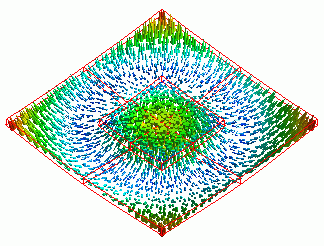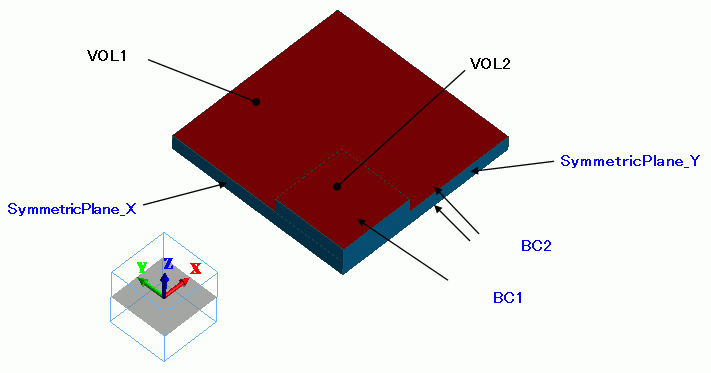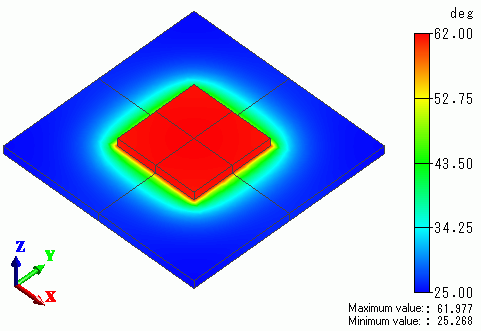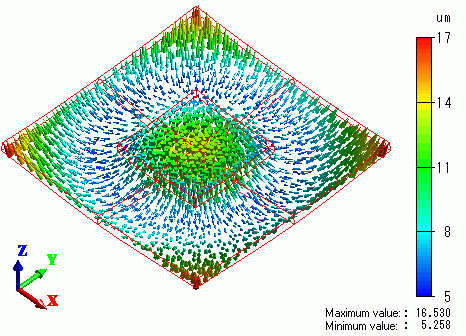
CAE Software【Femtet】Murata Software Co., Ltd.

Example7 Model with Reflective Symmetry

General
-
A quarter model of Exercise 2 is analyzed with reflective symmetry applied.
The figure above is obtained with [Full Model].
-
The reflective symmetry is used as boundary condition.
-
The temperature gradient caused by the heating chip is calculated by thermal analysis [Watt].
The result is passed on to Galileo as a thermal load.
-
The deformation, the displacement and the mechanical stress are solved.
-
Unless specified in the list below, the default conditions will be applied.
Analysis Space
|
Item |
Settings |
|
Analysis Space |
3D |
|
Model unit |
mm |
Analysis Conditions
Select Thermal analysis and Mechanical stress analysis.
|
Item |
Settings |
|
Solver |
Thermal Analysis [Watt] |
|
Thermal-Analysis Type |
Steady-State Analysis |
|
Options |
N/A * |
* “Thermal Load” is selected by default for the thermal load-mechanical stress coupled analysis.
The Step/Thermal Load tab is set as follows.
|
Tabs |
Setting Item |
Settings |
|
Step/Thermal Load * |
Reference temperature |
25[deg] |
* The reached temperatures come from the thermal analysis.
Model
This is a quarter model of Exercise 2.
The planes of symmetry are YX and ZX planes.

Body Attributes and Materials
|
Body Number/Type |
Body Attribute Name |
Material Name |
|
0/Solid |
VOL1 |
006_Glass_epoxy * |
|
1/Solid |
VOL2 |
001_Alumina * |
* Available from the Material DB
As for the heat source of VOL2
enter 0.25[W] which is a quarter of the original model.
|
Body Attribute Name |
Tab |
Setting |
|
VOL2 |
Heat Source |
0.25[W] |
Boundary Conditions
Set reflective symmetry on the applicable topologies.
|
Boundary Condition Name/Topology |
Tab |
Boundary Condition Type |
Settings |
|
SymmetricPlane_X/Face |
Symmetry/Continuity |
Symmetry |
Reflective |
|
SymmetricPlane_Y/Face |
Symmetry/Continuity |
Symmetry |
Reflective |
The heat transfer coefficients for the forced convection are calculated as follows. See [Heat Transfer/Ambient Radiation] for more information.
h = 3.86 x (V/L)0.5xC [W/m2/deg]
where
Air flow V=1[m/s]
Top and bottom faces of the substrate (VOL1): Characteristic length L=0.05, C=1 -> h=17.26
Top face of the heat source (VOL2): Characteristic length L=0.02, L’=0.015, C=1 * -> h=27.3
*
The thickness (d) of the speed boundary layer at the edges of the heat source is given by
d=0.0182x(L’/V)0.5= 2.3[mm]
This is close enough to the thickness of heat source, so we set C=1.
|
Boundary Condition Name/Topology |
Tab |
Boundary Condition Type |
Settings |
|
BC1/Face |
Thermal |
Heat Transfer/Ambient Radiation |
Heat transfer coefficient: 17.26[W/m2/deg] Room temperature: 25[deg] |
|
BC2/Face |
Thermal |
Heat Transfer/Ambient Radiation |
Heat transfer coefficient: 27.3[W/m2/deg] Room temperature: 25[deg] |
Thermal analysis is performed based on the boundary conditions below. The resulting temperature distribution is forwarded to mechanical stress analysis.
Results
The temperature distribution as a result of Watt is shown below.

The next figure shows the vectors of displacement as a result of Galileo following Watt.

They are quite similar to the results of Exercise 2.

